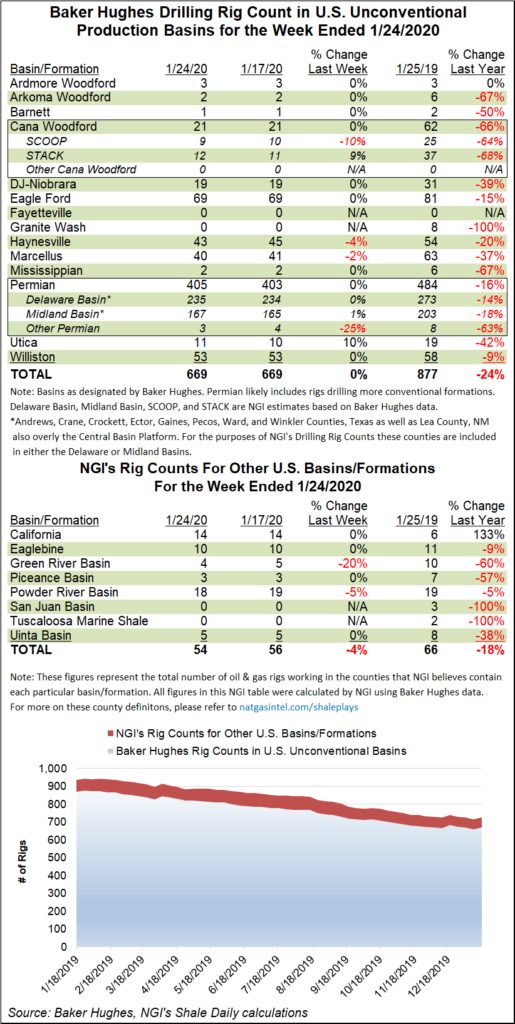Shale Daily | E&P | NGI All News Access | NGI The Weekly Gas Market Report
U.S. Oil Rigs Up, Natural Gas Rigs Down in Latest Count
A pullback in natural gas-directed drilling and an uptick in the oil patch kept the overall U.S. rig count mostly steady during the week ended Friday (Jan. 24), according to the latest numbers from Baker Hughes Co. (BKR).

In the United States, five gas-directed rigs exited the patch for the week, partially offset by the addition of three oil-directed, leaving the combined domestic count down two to 794. That’s off from 1,059 in the year-ago period, according to BKR.
Three land rigs departed overall, while one rig was added in the Gulf of Mexico. Six vertical units packed up shop, while drillers added three directional rigs and one horizontal rig.
The Canadian rig count finished flat week/week at 244, with a two-rig increase in oil activity offsetting a two-rig decline in the gas patch. The Canadian count finished the week slightly ahead of its year-ago tally of 232.
The combined North American rig count ended the week at 1,038, down from 1,291 in the year-ago period.
Among plays, two gassy formations — the Haynesville and Marcellus shales — each saw activity slow during the week. Two rigs departed in the Haynesville, putting it at 43 rigs, versus 54 a year ago; one rig exited in the Marcellus, dropping the play to 40 rigs from 63 a year ago.
Two rigs were added in the Permian Basin during the week, while the Utica Shale added one rig, according to BKR.
Among states, New Mexico saw four rigs join the patch, boosting its total to 109, down slightly from 112 in the year-ago period. Texas, meanwhile, dropped four rigs to fall to 397 versus 517 a year ago.
Also among states, Wyoming dropped two rigs week/week, while West Virginia dropped one. Ohio added one rig, in line with the increase in the Utica.
Oil and natural gas production from seven of the United States’ most prolific onshore unconventional plays is expected to increase in February compared with January, but at a markedly slower pace than in the recent past, the Energy Information Administration (EIA) said in its recent Drilling Productivity Report.
Total oil production from the Anadarko, Appalachian and Permian basins, and the Bakken, Eagle Ford, Haynesville and Niobrara formations, is expected to increase by only 22,000 b/d in February from January. Total natural gas production from the seven plays is expected to be 85.99 Bcf/d in February, compared with 85.92 Bcf/d this month, EIA said.
Drilled but uncompleted (DUC) well counts across the Big Seven ended December at 7,573, a decrease of 50 from November, EIA said. DUCs decreased in three plays, with the Anadarko down by 54 to 632, Appalachia down by 21 to 427, and the Eagle Ford down by 15 to 1,427. The Bakken added 18 DUCs to reach 813, the Haynesville added six to 214, the Niobrara added two to 448, and the Permian added 14 to reach 3,612.
© 2024 Natural Gas Intelligence. All rights reserved.
ISSN © 2577-9877 | ISSN © 1532-1266 | ISSN © 2158-8023 |
